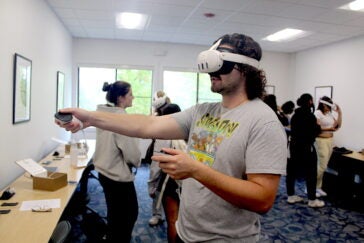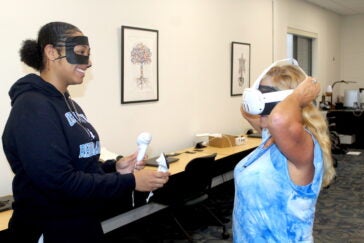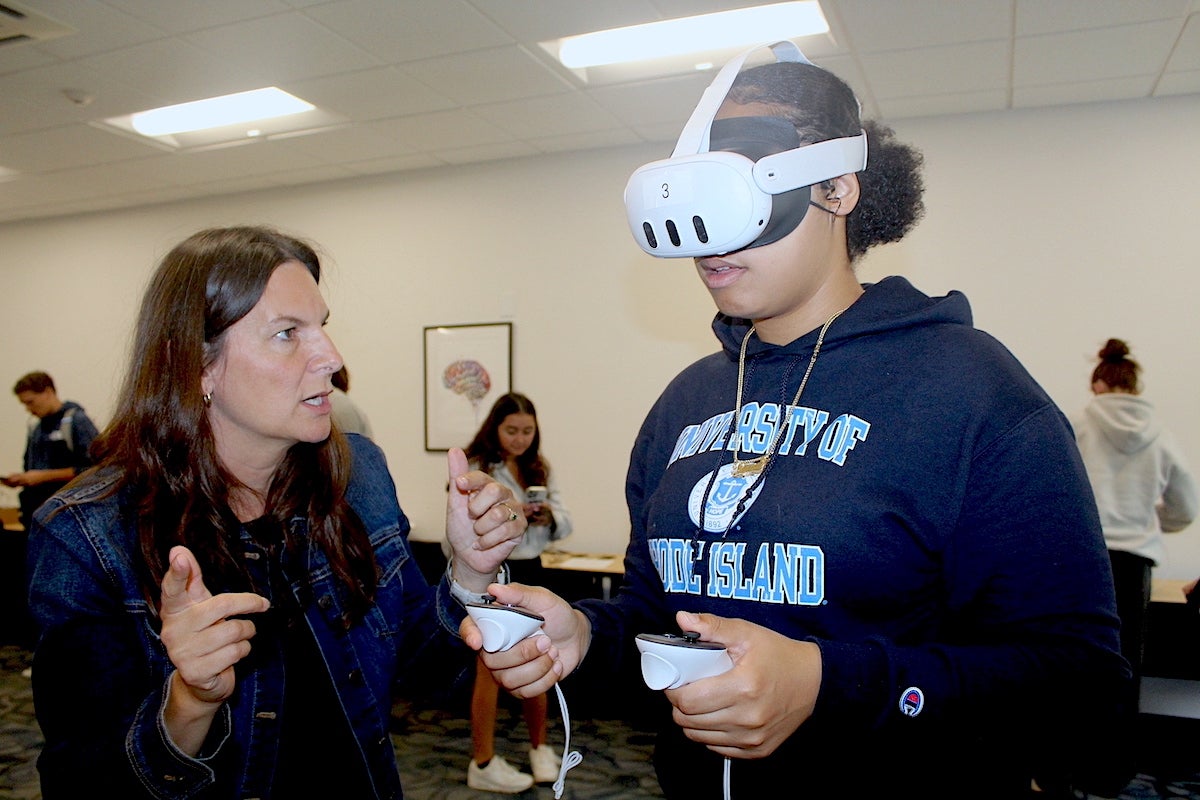College of Nursing recently introduced its new VR lab in Kingston
Nursing students at the University of Rhode Island now have the opportunity to assess and interact with patients in their hospital rooms, make decisions about the care they need, and perform the required treatment, all from the safety of a lab in White Hall, home of the URI College of Nursing on the Kingston campus.
The college recently introduced its new Virtual Reality lab, which features Oculus Quest VR headsets and hand controls. The software, from UBISIM, transports students directly into a patient’s hospital room with all the furniture and equipment one would expect to find there. Students can move around the hospital bed, assess vital signs, interact with the patient, and provide whatever treatment is required. They are able to make decisions about the patient’s care and see the results of those decisions in real time, allowing them to learn on virtual patients before heading to their clinical rotations in real life, according to Simulation Education Coordinator Jessica Skaltsis.

“This gives students a chance to do a physical exam and go through the steps you would take to provide treatment—giving medications, performing an EKG, assessing vital signs,” Skaltsis said. “It gives you a very good idea of what you need to do in a patient encounter. It will never replace actual hands-on work, but you can still get great practice working with virtual patients.”
Professors can program multiple situations for student nurses in pediatrics, medical-surgical, obstetrics, and mental health. Scenarios cover such conditions as abdominal pain, heart attacks, diabetic complications, end-of-life care, labor and delivery, and many more. Nursing students can read healthcare providers’ orders, review chest x-rays, EKGs and lab work, perform treatments, and, most importantly, recognize and respond to changes in the patient’s condition.
The VR lab houses several devices, allowing multiple students to engage in different scenarios. Professors can watch students’ interactions with patients in the virtual hospital room, and replay the scenario during a debriefing afterward, giving direction on what they did correctly and what could be improved.
 The virtual reality lab works hand-in-hand with the College’s advanced simulation labs, which feature computerized, lifelike mannequins that mimic an actual patient experience. During simulations, the mannequins can talk, cry, sweat and even bleed, replicating various vital signs that students must analyze, giving them hands-on practice. The college also employs live actors trained in medical simulation to portray patients, furthering the live experience and giving students the chance to practice direct communication with those in their care.
The virtual reality lab works hand-in-hand with the College’s advanced simulation labs, which feature computerized, lifelike mannequins that mimic an actual patient experience. During simulations, the mannequins can talk, cry, sweat and even bleed, replicating various vital signs that students must analyze, giving them hands-on practice. The college also employs live actors trained in medical simulation to portray patients, furthering the live experience and giving students the chance to practice direct communication with those in their care.
The VR lab gives students a similar experience, supplementing their hands-on work. It can also help fill the gaps when students miss classes or are displaced, as they were during the COVID-19 pandemic when they were often unable to attend their in-person rotations due to locked down medical facilities.
“Hopefully, they come away from the VR hospital room knowing what they need to do to help the patient in each scenario,” Skaltsis said. “This is certainly not a replacement for in-person practice, but it augments their current experiences, allowing students to think critically and make necessary decisions about the care the patient needs.”

